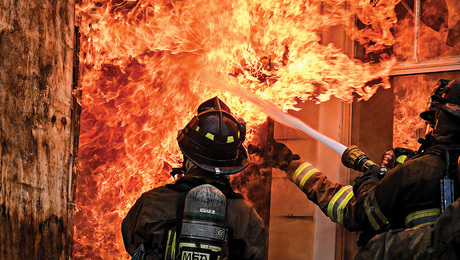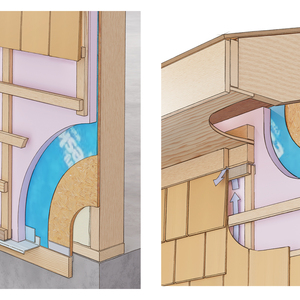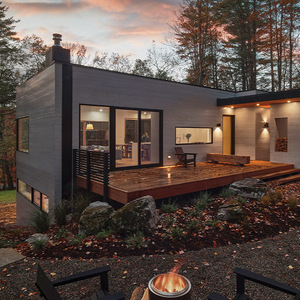thermostat location, duct instulation,
three questions
1. Where is the best place to locate a thermostat? one level ranch house living room kitchen dining open floor plan with 10′ ceiling then a center hall going to the bedrooms with a 8′ ceiling the cold air return is at the beginning of this hall on the ceiling. The hall is about 14 feet long. The thermostat is right below the return, is another loction better? the end of the hall?
The furnance cycles on and off every few minutes.
2. The house has a crawlspace, the ducting is here, furanance in garage, cold air in attic (The attic is flex and insulated) . The duct work is steel what is the best way to insulate it or should it be insulated? The two foot foundation walls have r 19. .
3. The master bedrm has vaulted ceiling it is two hot in summer and too cold in winter (yes we have central ac) but no cold air return. The vault runs one side of roof to the peak of the house.
Should a cold air return be added to this room? How to size it
Or add one and move the hall one at the 8′ ceiling higher up and on to the living dining room wall?



















Replies
Off the top, I feel like I just walked in to a show that's been going on for a while. What's the real story?
Also ... with the variety of issues your post suggests .... I really think you need a pro. While the installation you describe has a few issues, none of them should cause the furnace to cycle as you describe. There's another problem going on there.
I just replaced the thermostat the old one had issues it was giving incorrect room temp reading much higher then actual. That seemed to help the cycling issue, which now happens at lower settings like 65 or so (but it has been cold out). The other item are issues that I have been wondering about to improve efficiencyand balance.
2. The house has a crawlspace, the ducting is here, furanance in garage, cold air in attic (The attic is flex and insulated) . The duct work is steel what is the best way to insulate it or should it be insulated? The two foot foundation walls have r 19
Off the cuff it sounds like your centralized cold air return is (a) undersized, (b) may have kink in it (flex should be stretched tight with as few bends aspposibl. My experience is that most are undersized.
Your stat location is normal. Close to center of the house and near a cold air return. You want it to satisfy when the return air is at the set point.
Insulating the crawl space duct work will help, but sealing all the joints is the first thing to do. You will improve the furnace efficiency with duct mastic and foil tape, then milk a few more btu from the system by wrapping insulation around the duct work. Go to an HVAC supply house for DIY suppies for ththese task, or hire a pro if you don't want to squirm around in that 2' crawl space.
With a central return all of your interior doors need to have a pretty good gap under them, or be left open as much as possible to let the supply air in each room get back to the return.
Vaulted rooms are a PITA for HVAC design. Ideally you should have two returns in a room with a vault, one high and one low. In the summer you want the high return to pull the hot air off the ceiling and the cool air up when the a/c i is on. Reverse that for heating season, so the returns can share the same trunk line, but should be dampered at the grill.
Short of doing that, adding a ceiling fan with forward/reverse switching can move the room air in the right direction to mix it for better heat/cool comfort.
Dave
thanks daveYou shed some great light on the location of the thermostat that eases my concern on that one.The flex is 14" and hardy taught, has two bends in it, goes up two feet across the living room ceiling then drops two feet. Also the outer layer has failed it has just crumbled. That is one reason I asked about adding a second return in the master, I figure if I am to replace it it would be a good time to rework it. Getting a return up high is an easy one, lower a bit of a trick could cut one into the stud bay so the upper and lower share the same bay with closing grills (there is another post on that issue). The issue I could run into on that is the sheetrockers thought it would be good to fill the stud bays with their scrap sheet rock, ran into that on other projects. As it stand now the furnance is a Carrier 1987 original to the house with an input of 75,000 btu's. The house is 1100 sf.As for the supply, paint the mastic over the seems let that dry then foil tape? As for insulation do you recomend any type or r value? As a kid I helped my dad insulate his duct work, he used a reinforced foil type fiberglass, the foil looked like rip stop nylon. But that was on the east coast and I have not seen any like that localy ( Idaho). We do have a ceiling fan in the living room and master, tend to use those more in the summer then winter. In winter they seem to make both rooms draftier (reversing them). The gaps on the bedroom doors are about one inch to hard wood floors ( no carpet in the whole house)Thanks Dave you shed some good insight I am getting tired on my wife saying how cold she is and turning the heat up. Our weather for December is a bit colder then usual.Wallyo
Don't just use any foil faced tape. You need to use the kind that has mastic as the glue. I had a hard time finding it but found it at Grainger. Kind of of expensive but there is a definite difference. I insulated my duct after sealing by framing it in with 2X2 wood studs. Then sprayed the space with tiger foam and then covered the whole thing with 1/2" Thermax. I figured an R12-14 was archived. I sprayed the joist cavities full with foam for each run that came off the main trunk line. It was hard to get on top of the duct so I installed R38 FG on top. It made a big difference. Jay
To allIf I add a cold air return to the master and size down the one in the hall any ideas on what size to make them? The hall is as I said 14" round 1100 sf.Wallyo
Do you know how much air is supplied to the room you want to add the return? The 14" flex is good for about 700 cfm, so I wouldn't downsize it. IF you add a return to the space, how are you going to do this? are you going to "homerun" this back to the furnace? Tie into the existing return in the area?
Think of air like water and plumbing. For every water supply (at least those inside the house) you need a drain. The drains are usually a lot bigger than the supplies. A typical power room lavatory will have (2) 1/2" supply lines, a hot and a cold, and (1) 1-1/4" or 1-1/2" drain. If you supplied a sink with 1/2" and tried to drain it with 1/2" you would end up with water where it doesn't belong.
If the bedroom has a 6" supply, use an 8" return. If there are two 6", use a 10" return, etc. This is just the actual ducting, in round sizes, not the size of the register or grille.
Something else to consider, as someone else noted, the proximity of a supply in the area could cause short cycling. Depending on the details of your furnace and your thermostat, you may be able to "set" the minimum cycle time. I know I can on mine.
Tim I was thnking that the supply was of no issue then I looked out the office door just now and noticed the supply across the hall in the bath room. It is mounted in a strange place the vanity is set in an alcove, there is a jog in the wall towards the toilet and it is here the supply vent is with fins that force the air left and right wich would, could in theory blow air right on the wall with the stat that is six feet away. The stat is here about three feet down that wall.The supply to master is 6" and has only one, I need to add a supply to the master bath room (this is an recent addition) which adjoins the bed room with a pocket door which usually is left closed at night for sure. I will probably put a six inch in.to sum up.The bedroom is 160 square feet the bath 90.
one 6" supply in bedroom.
Both rooms have vaulted ceilings
I could home run it or tie in to the existing.
the peleum is steel with a 20" x 16" interior. It stops at the ceiling level and there is a round 14" adapter collar in the attic that the flex attaches to.So if I home run it I would need to extend the plenium into the attic (to make it worth a difference) or add an inlet to the side elbow it up through the ceiling.Or since the supply needs replacing ( the failing outer layer) I could increase it to 16" maybe ( the outside of the plenium is larger due to insulation on the inside) and tie in just before the existing return, reducing the 16 to a wye with a 14 going to the existing return and a 8 or 10 to the bedroom.What would you do?I attached two photos of the vent situation in the hall bath one from hal to bath the other bath to hall.thanks in advanceWallyo
1. The supply in the floor of the bath is not causing your cycling problem unless it screams (like, blows a whole lot of air) when the furnace runs. That looks like a 10x2 which will pass about 50 to 60 cfm.
2. I think we're mixing up some terms here, or I don't fully understand your situation. As I understand it, you have a downflow furnace/air handler in a closet in your one story house, with the supply (i.e. that ducts that supply air to the space) ducts run through the crawl space and the return (i.e. that duct that return air to the furnace to be heated up again) duct runs through the attic. This is the 14" flex duct and the the only return for the system.
3. What would I do? First, I would have to replace that red switch plate cover to something closer to beige or amond! Seriously, there are many reasons why a furnace will cycle excessively. Usually, the culprit is a combination of less than ideal features or a particular installation. What I would do is examine all of the possibilities and eliminate as many as possible, starting with the easiest first.
Thermost - location, funtion and/or programming. An ideal location for a thermostat is on an interior wall, where it will never be exposed to direct sunlight, in an area that is representative of the "zone" to be controlled. Sometimes that is near a well-placed return, sometimes not, depending on all factors. Function: most thermostats have a "deadband" that is usually adjustable.The deadband is the difference between the setpoint at which the thermostat opens with increasing (stops calling for heat) and the point at which it closes with decreasing temperature (starts calling for heat again). If this deadband is too small, short cycling can occur. If the db is too large, uncomfortable temperature swings will exist between cycles. Modern digital programmable thermostats have a great deal of features that must be set-up at installation. With some brands/models this will include deadband setting and cycles per hour (usually for 90%+ efficient furnaces).
Oversized equipment - if a unit is oversized or poorly installed such that the heat is very concentracted in a small area, the unit will be cable of satisifying the thermostat very quickley. How big is the house, how is constructed, where is it located and what is make and model of your furnace (year of manufacturer might be important too)?
Environment - factors other the operation of the system or its controls are affecting the response of the thermostat - in reality, this is a location problem.
Poor air distribution - this is one is tough to defien exaclty, tougher to diagnose without being there and depending on the details maybe not practical to change. Ideally, you want the air to follow a path that covers as much of the living space in as unnoticeable a manner as possible. Clear as mud, right? Say you have a corner, exterior room with a single supply and a single return. You would want to put the supply nearest the greatest heat loss, which would be the corner with two outside walls and/or near the window(s). If you supply in the NE floor corner, the best place for a single return would be the SW corner of the ceiling. Air goes only where you make it or allow it to go, not where you wish it to go.
Service Issues - there are some operational problems that could cause short cycling depending on the details of the fan timer and gas control logic. These would best be diagnosed and repaired by a qualified technician.
Has this system worked satisfactorily in the past? If so, what is different? What have you changed? Did the change create the problem?
On point 2 you are right on. Only the furnance is in the attached garage 1100 sf house. I guess my question is if I were to add a return to the master bed room what size to make it 8 or 10? And if I were to split the current return and tie in the new master bed right before the grill in the hall Would I increase ithe main to 16 from 14 or leave it at 14 from the furnance to that point? Or is it better to home run the new return back to the furnance?The crawl space has a large metal round supply that goes down the center of the house till about the halls end with mostly 6 inch supplies spidering off that. I think the main trunk is 16 not fourteen I would have to get down there and measure that one. But lets say it it fourteen by your reasoning (ie the plumbing) should the return be larger then the supply not the same size?Thanks againPs it is a honeywell programable I just installed I don't think the dead band is adjustable on it. There is a high efficient switch on the back that I remember I left it in standard position ( so it might adjust by internal programing). Also I am in process of changing out switch plates to white on white through out the house. The red was my wife's primary color phase.
If I were to size a return duct for a room at the end of the line with only a single 6" supply, I would use 8" round duct if the run is 20 feet or less, 10" if its more, and a 14x8 return grille. This is just my best guess from far away.
As far as the size of the main return trunk I can't addrees that without knowing the intended air flow through it. However, simply attaching a new return duct branch to the main duct near the main return grille will be a waste of effort. All the air will still go through the grille. If it is a register, i.e. a grille with a damper built-in or there is a volume damper in the duct, you could force the new return to pass the required volume but at a net decrease in the system (you just increase the overall system resistance).
You believe that the return air configuration is causing your short cycling? That IS what you are trying to remedy, right? Short-cycling? My opinion is that neither duct sealing or the return in the MBR is going to significantly affect the cycle time of your furnace. While these are important issues to address, not the first issue to address, as you posed your issue.
No I think the short cycling I think is a total and different issue, I have done most maintance on this furance myself three years ago new blower motor, this summer new electronic control board, last month new stat all part correctly cross referenced and purchased through Johnstone Supply. But I noticed last night that when there is a call for heat this is what happened.1. ingiter sparks
2. pilot flames up
3. 60 seconds plus later burners flame up
4. 20 seconds later burners flame off
5. Pilot stayed lit
6. 30 seconds later burner flames up again
7. blower starts.So maybe a valve problem, limit switch. etc what could also be happening but did not this time is that between 4 and five the blower may or may not be coming on. Can not remember last night but now I replicated it and the blower did not come on. Might be time for a new furance anyway ( do you have a opinion on brand or single or multi stage) Dave Richison might be right time to replace it!The bed room is different when it is real hot outside in summer it is real hot in there. When cold out in winter it is cold in there. This week a bit better it has only been in the thirtys at night last week it was in the twenties. I just think with the high ceiling the air flow could be better in there circulate that hot high air in a better fashion.
Based on your decription of the sequence, your problem is in the gas control components. The logic is goofy. The burners shut down before the bonnet temperature sensor allows the start of the fan?
A red flag....." this summer new electronic control board," ... :)
Yeah, the problem with the old board was the solenoid was burned out and they were soldiered on So new board. When replacing I followed wire for wire triple checking, the instructions were pretty clear also.When you say gas control do you mean the valve, the bonnet sensor, control board or all the above?
Edited 12/19/2007 2:54 pm ET by wallyo
All of the above.
Darn, I love it when you finally show up.
I learned something new from you agian.
Dave
As always, thanks for your kind words. As you know this forum can be addictive and I still have to earn a living. From time to time, I have to visit and see what's going on.
Here's hoping that you have a great Christmas!
Hey Tim,
Ditto what Dave said.
As for the supply, paint the mastic over the seems let that dry then foil tape? As for insulation do you recomend any type or r value? As a kid I helped my dad insulate his duct work, he used a reinforced foil type fiberglass, the foil looked like rip stop nylon. But that was on the east coast and I have not seen any like that localy ( Idaho
You got it.
Jay is right about the foil tape. Nashua and Venturi are good brands.. Both are peel and stick type, so they are a little more labor intensive, and they are expensive.
With a furnace that old, I would start thinking about upgrading to a new 90+ model. You are likely operating between 60 and 80% efficeincy with what you have. Payback on that type of investment is always an issue, but I think if you run the numbers for your climate, you'll find a way to afford one.
While you are up in that attic repairing and running new returns start sealing all the leak points you can get to. Wire, plumbing vent penetrations, aound light fixture boxes, or just anywhere anything has gone through the framing or drywall. do the same thing in the crawl space and you will cut way down on that drafty feeling you get in older homes. It will also reduce your heat/cooling cost.
Dave
We used to have the thermostat in the central hallway of our ranch. Unfortunatly, that was the place that bore little resemblance to the rest ot the house in temprature.
I had it moved to the opened Living/Dining/Kitchen space. When that area is comfortable, the whole house is too.
I'd hate to know how much sound transfer you have between the rooms with those gaps under the doors AND hardwood floors. I guess everyone goes to sleep and wakes up the same time in your house. I sealed up our doorways and had return registers put in each room.
Rebuilding my home in Cypress, CA
Also a CRX fanatic!
If your hair looks funny, it's because God likes to scratch his nuts. You nut, you.
Wherever you put the t stat, make sure there is not a vent that blows on, or near it...I had one that was in the recommended place, near a return etc. Only problem, there was a heat vent in the can that was about 12 ft away, and it blew right at it. Made for short cycles. I moved it about another 12 ft down the hall and now it cycles fine.
Bud